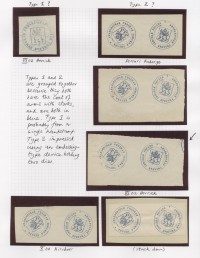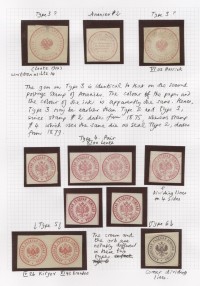The Official Stamps [Dienstmarken] of Ananiev Zemstvo
Trevor Pateman
Introduction
A postage stamp is traditionally defined along these lines: It is a label affixed to a postal item (letter, packet) as an indication or proof that some or all postal charges have been paid in advance, and such that the item is entitled to be carried and such that the recipient should not be charged for what has already been pre-paid.
A postage stamp may, and usually does, contain an indication of how much has been paid towards postal charges and, in some cases, what kind of charges those are (Registration, Express Delivery and so on).
Postage stamps are cancelled by some means for several reasons, of which one is to prevent the fraudulent re-use of the label.
At some times and in some places, special labels have been issued to or by government departments and other bodies designed to function as postage stamps on approved categories of mail. They generally carry an indication of value, and since they are items accounted for financially, they are again cancelled when used to prevent re-use. Accounting for use of such labels is part of the job of what we would now call a cost centre. Stamp catalogues list these special labels as "Official Stamps" [ "Dienstmarken" , "Timbres de Service"].
In contrast, at some times and in some places - for example, Imperial Russia - various organisations have been granted mail privileges by the government, such that they do not have to pre-pay any postage on items they send through the regular mail service.
All that is then required to secure entitlement to mail carriage is some indication that a postal item is entitled to the Free Frank privilege which has been granted. This may involve writing a number on the item which identifies the organisation or it may involve stamping the item with an identifying cachet or it can involve affixing a wax seal or paper label or some combination of these.
When no financial accounting is involved, at least for the sending organisation, then there is no need to cancel the indication of entitlement since no fraud is possible. If an organisation can send as many letters as it likes, cost free, there is no fraud in - for example - re-using a label which shows its entitlement. The postal service may be counting how many Free Frank items it handles and may even charge somewhere else for such carriage but cancelling labels is irrelevant to this task. The sending organisation may keep a record of its mail, and it may number items sent consecutively so that a number on the actual item correpsonds to a number in an accounting book: Terry Page tells me that this was standard Zemstvo practice, and it is a practice which would serve to prevent misuse of a Free Frank privilege.
A Free Frank seal or label is like the negative or other of a postage stamp. It signifies that the postal item is entitled to be carried, but that the postal service cannot charge the sender for its services - and, perhaps as important, cannot charge the recipient either.
The argumentative reader may see all kinds of holes and pitfalls in this brief analysis, and many shades of grey. And he or she would be right to do so.
The Official Stamps of Ananiev Zemstvo
In his 1882 catalogue of Zemstvo stamps, published in Vienna, Hugo Lubkert lists seven stamps for Ananiev of which Number 6 is described as “For Official Correspondence”, in blue and without indication of value. He gives the issue date as September 1880. His description of this “stamp” is accurate, in particular in noting that the inscription in the outer double circle is identical to that for the regular stamp, also in blue, which he lists as Number 4 (issued he says in June 1880), and which is also listed as Number 4 by both Schmidt and Chuchin. He notes that his number 6 “stamp” is printed in horizontal pairs in two different varieties. This is correct. Stamp Number 4 is also printed in horizontal pairs, and though there are differences in detail (one sub-type of Number 4 lacks a Star in the outer double-ring circle whereas both sub-types of Number 6 have the Star), number 4 and number 6 were created from the same tray of typefaces and printed at the same desk.
Much later, Schmidt in the 1932 “Big” Schmidt catalogue has a note at the end of his entry for Ananiev which dismisses the “so-called “Official Stamps” [Dienstmarken]” as simple paper seals [Verschlussoblaten - literally, Sealing Wafers] which were used in all Zemstvo districts. In the “Small” Schmidt catalogue (1934) Schmidt records for Ananiev that he has donated to the Postal Museum eight assorted [Versch.] paper seals [Siegelmarken] previously described as Official Stamps [als Dienstmarken ausgefuhrt].
This might seem to be the end of the matter. Paper seals are not Official Stamps in anyone's catalogue. But one or two questions remain.
Why does there appear to be no other Zemstvo for which paper seals have been passed off as Official stamps? Neither Small Schmidt or Big Schmidt appears to contain any other reference to such confusion than this one I have cited. Was it just a local scam, in which some bright Ananiev clerk realised you could sell paper seals - which actually had no face value and which you could print ad libitum - to collectors by claiming they were “Dienstmarken” , or was there some basis for Lubkert’s Number 6 listing back in 1882?
It is clearly quite interesting that there are close similarities between the regular stamp Number 4 and the seal, but this may not be a unique case and probably isn’t. One could look at the seals of Alexandria, for example, which are similar to the postage stamps of that Zemstvo. (See Bill Nickle’s article in Rossica Nr 133, October 1999, for illustrations of Alexandria seals)
One might also want to look again at Maloarchangelsk 1 and 2 in the light of the present discussion and ask the shocking question of why the relatively common “stamp” without indication of value is not simply a paper seal for official use, then converted to a regular but very rare postage stamp by the addition of the manuscript indication of value “5k”. Other Zemstvo "stamps" without indication of value might prompt the same question.
It may also be relevant that there is another Ananiev seal in blue with three storks in the centre, which looks like a handstamp and which may have preceded in use the more carefully produced Lubkert 6 seals. These would then have looked like an attempt to upgrade the sealing system with “proper” adhesives - all my examples of Lubkert 6 are clear strikes on good quality gummed paper, identical to that used for stamp number 4.
Collectors at the time may not have been clear in their own minds where stamps ended and seals began.
Agathon Faberge, for example, made a careful collection of Ananiev seals accumulating 22 seals in six different types. This collection has only recently surfaced, the most likely explanation being that Oleg Faberge removed the seals from the ‘core’ Faberge Zemstvo collection in the light of Schmidt’s dismissive opinion of them and consigned them to the oblivion of a stockbook of odds and ends which eventually became Lot 407 in the Kaj Hellman auction of October 8, 2005.
Of these 22 seals, ten are Lubkert’s Number 6, all of them in complete sheetlets of two stamps. Three of the sheetlets have acquisition notes in Agathon Faberge’s handwriting: one pair came from Kirchner in October 1900, a second pair from Herrick in June 1902, and a third pair is handstamped in red FERRARI FABERGE, thus acquired when Faberge bought Ferrari’s collection.
This final pair also has a pencilled note on the reverse, not in either Agathon or Oleg Faberge’s handwriting. It reads, “ca. 1/ 2 Jahr als Provisor. in cours [? a French not a German word] gewesen. Officielles Papir Marken [? Marken is an uncertain transcription]”.This translates as “In use as a Provisional for about half a year. Stamps for official papers.” This is followed by what could be a signature, “T Karis” or “T Kuris”.
The obvious next research question is to identify the signatory. Was he the Ananiev postmaster or was he a stamp dealer? It is unlikely that the pencilled note is Ferrari’s since he would have surely written in French.
Below, I illustrate the five pairs of Lubkert Number 6 which were in the Faberge collection, and then show the other 12 Ananev seals, many of which also have pencilled Faberge acquisition notes. I have placed these seals in tentative chronological order, but indicating some uncertainties about this chronology in the notes which accompany the illustrations.
Click on a sheet below to see a larger view.


The collection of 22 Seals has now been sold.
Acknowledgment
Terry Page kindly commented on the draft of this short article, correcting mistakes. Responsibility for the remaining mistakes and the judgements made is my own.
November 2005